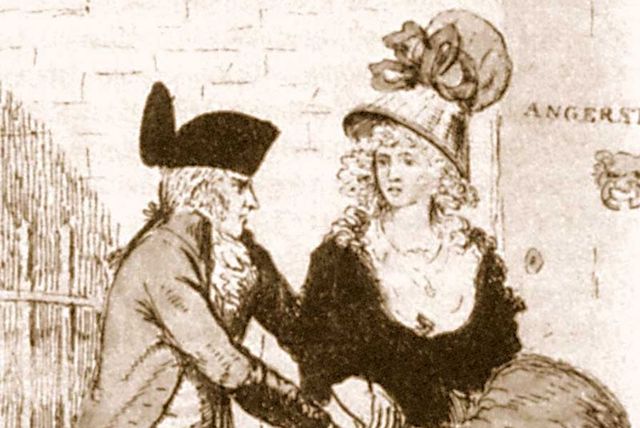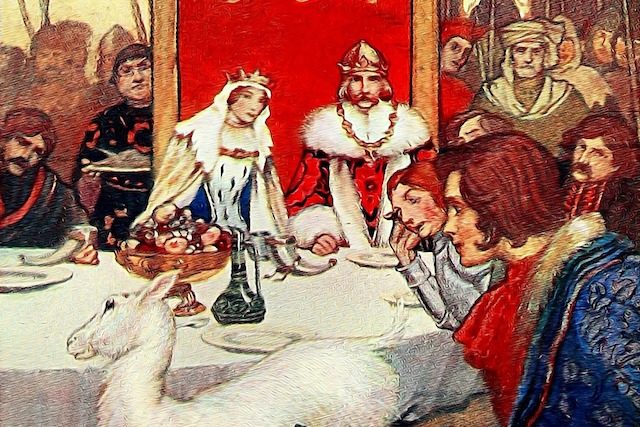Finding out with absolute certainty what happened hundreds or even thousands of years ago is an almost impossible task. Scholars try their best, but they are limited from the outset by the historical evidence they have at their disposal. Today we look at 10 well-known figures from the past whose place in the historical record is uncertain enough that some people have doubted their very existence.
10. Lycurgus of Sparta

Even by ancient history standards, the existence of Lycurgus is poorly attested, even though he was, arguably, the most important Spartan in history and the one mainly responsible for transforming the city-state into the most feared and powerful nation of the Greek world.
This is because the Spartans simply weren’t interested in keeping written records. We found out about Lycurgus from external sources, mainly Greek philosophers and historians, such as Herodotus, Xenophon, and Plato. But by that point, hundreds of years have already passed, so whatever historical fact may have existed got mixed in with legend and myth.
If Lycurgus did exist, he would have lived around 800 BC. After traveling around the Greek world, Lycurgus decided that it was time for a change in Sparta, so he returned home and enacted the set of laws known as the Great Rhetra which transformed Sparta into the fierce military society that gained everlasting notoriety.
9. Jenny Geddes

The story of Jenny Geddes is a perfect example of the butterfly effect: a seemingly-insignificant incident that, ultimately, leads to a much greater and momentous event. In this case, we start with an angry woman throwing a chair and end with the execution of Charles I, King of England, Scotland, and Ireland.
The story begins in 1637, at St. Giles Cathedral in Edinburgh. Tensions were already pretty high between the English and the Scots, and they were exacerbated by the fact that King Charles I seemed determined to force Scotland to abide by the religious rites of the Church of England, whether it wanted to or not. On the day in question, the Dean of Edinburgh began reading for the first time from the newly-printed Scottish version of the Book of Common Prayer, to the dismay of his congregation.
One woman named Jenny Geddes decided she wasn’t going to sit there and take it. “Devil cause you colic, false thief: dare you say the Mass in my ear?” she shouted, as she got up and threw her folding stool at his head. A full-scale riot ensued, which spread to all of Edinburgh, and then all of Scotland. That act is now considered a catalyst for the War of the Three Kingdoms, which ended with Charles’ execution.
All of this was well and good, but historical evidence for the existence of Jenny Geddes has proven hard to come by. Maybe she was never real, or maybe it was just a random name given to the unknown woman who actually threw the chair. Some have even speculated that Jenny and her friends may have actually been apprentices dressed in women’s clothing, who attended church specifically to cause a riot.
8. The London Monster

A hundred years before the infamous Jack the Ripper, London was terrorized by the crime spree of another maniac, one who liked to follow women around at night, cut up their dresses, and prick them in the buttocks using a knife or a needle. He became known as the London Monster and may have been responsible for over 50 attacks over a two-year period but, at the same time, he may have never existed at all and simply been a product of mass hysteria.
But what exactly caused it in the first place? While a few attacks on women certainly happened, there was nothing to suggest they were caused by the same man. The newspapers certainly sowed the seeds of panic, as did criminals who often used cries of “Monster!” to create a frenzied mob and escape in the ensuing confusion. Then there were also women who claimed to be victims of the Monster for the attention.
The drama came to a head in 1790, when a 23-year-old Welshman named Rhynwick Williams was charged with the crimes, but his trial was a complete farce. Some of the women called to testify admitted to making the whole thing up, while others positively claimed that Williams was not the man who attacked them. Ultimately, he was still convicted of three charges and sentenced to six years in prison and this seemed to help the whole hysteria die down and the London Monster was never heard from again.
7. William Tell

There is no denying that William Tell is an important folk hero and a pivotal figure in the history of Switzerland as a man who stood up to foreign tyranny but the question is: was he real?
His story takes us back to 1307, to the town of Altdorf, at a time when Switzerland was under the dominion of the Austrian House of Habsburg. As a sign of his authority, the tyrannical local bailiff Albrecht Gessler placed his hat atop a pole in the market square and demanded that all who passed bow before it. One day, a peasant named William Tell walked by the hat with his son and refused to bow. As punishment, Gessler demanded that Tell shoot an apple off his son’s head in one try from 120 paces or face execution. William Tell succeeded, so his life was spared, even though he was still sent to prison. On the way there, he escaped and eventually assassinated Gessler, starting a rebellion that led to the liberation of Switzerland.
It was a crucial moment, but scholars remain unable to trace the actions to a historical figure named William Tell. His story wasn’t even written until hundreds of years later and, controversially, the apple shot scene seemed to be based on an older Danish tale involving a Viking named Toko and King Harald Bluetooth.
6. Yang Kyoungjong

At first, the story of Yang Kyoungjong seems perfect as one of those random facts you can whip out during a conversation: he was the only soldier to have fought on three sides during World War II.
As a native Korean, Yang was first conscripted into the Imperial Japanese Army at the start of the war, since Korea was part of the Empire of Japan back then. During battle, he was captured by the Soviets and sent to a gulag, but later was pressed into the Red Army to fight Nazi Germany on Europe’s eastern front. There, he was once again captured and became a POW of the Wehrmacht and sent to Occupied France, where he was forced to defend Normandy during D-Day. There, he was taken prisoner one last time by US paratroopers, which is when the famous photograph was taken, purportedly showing Yang wearing a German Wehrmacht uniform.
His story was often shared without too much scrutiny, at least until 2005 when a South Korean company wanted to film a documentary about Yang Kyoungjong. They quickly discovered that there were no records to attest that he fought for Japan, the USSR, and Nazi Germany. Furthermore, they also found that nobody really knew for sure who the Asian man in the famous photograph was, as the Americans could not communicate with him and simply labeled the picture as “Japanese man.”
5. Agnus McVee
Gather around the fire, everyone, to hear the tale of Agnus McVee, a ruthless and bloodthirsty Scottish woman who operated a “murder hotel” along Canada’s Cariboo Wagon Road during the Cariboo Gold Rush of the late 19th century. It is said that Agnus, alongside her husband Jim McVee and her son-in-law Al Riley, kidnapped young women and sold them as sex slaves, and also killed miners who stayed at their hotel, the 108 Mile House, in order to steal their gold.
Allegedly, Agnus and her accomplices were responsible for over 50 killings and were only discovered after one of the girls they kidnapped managed to escape and tell the authorities about the gruesome goings-on at the 108 Mile House. It is said that Agnus buried all of the gold she took off her victims and every now and then, people still find some of these lost treasures, as a reminder of the trail of blood left by Agnus McVee.
It sure makes for a good story, but it seems like the legend of Agnus McVee may have originated during the 1970s, in a book about buried treasure in British Columbia. You would think that a killing spree that left over 50 people dead might be newsworthy, but historians couldn’t find mentions of it in newspapers of the day.
4. Menes
Including Egyptian pharaohs almost feels like cheating a little bit since there are many of them who are only known as names inscribed on a wall. But we aren’t going with just any pharaoh – Menes, if he existed, would have been the first pharaoh, the one who united Upper and Lower Egypt into a single empire.
The reason we are uncertain of his existence is that we have two different men who both claimed to have unified Egypt. One of them is Menes and the other is called Narmer. We have more evidence to suggest that Narmer was legit, including the Narmer Palette, a contemporary tablet that not only depicts the unification but also shows Narmer wearing both the crowns of Upper and Lower Egypt, an important symbol that signified the pharaoh’s authority over the two lands.
So, then, where does that leave Menes? It is possible that he was a mythical figure, or maybe a different pharaoh who came after Narmer, but there is also a strong belief among Egyptologists that he and Narmer might have been one and the same person. Unless we find more evidence, this remains just speculation.
3. John Henry

The legend of John Henry is one story that most American kids will hear at least once in their lives. During the mid-to-late 19th century, John Henry was a big, strong Black man who worked on the railroads as a steel driver. His job involved swinging a giant sledgehammer to drill holes into the rock to make room for dynamite. It was arduous, backbreaking labor, but one that John Henry did not want to give up. Therefore, when the railroad company brought in a steam-powered drill to speed up the process, Henry insisted that he was still the better option.
And so a challenge was set – John Henry versus the drill, man versus machine. Henry picked up two large hammers and started pounding away at the rock, drilling a 14-foot hole whereas the machine only managed to penetrate nine feet. John Henry had won the contest and then he collapsed of exhaustion and died with the “hammer in his hand.”
Since then, the tale of John Henry has been passed around numerous times, in the forms of stories, and ballads, and novels. But whether or not there ever was a real John Henry remains a mystery. For most of his existence, he has been regarded simply as a folk hero, but some historians in recent decades believe they may have found the real John Henry – a former Union soldier who was imprisoned for theft in Richmond, Virginia, and then sent to work on the railroad.
2. William Shakespeare

We arrive now at a conspiracy that has been going strong for over 150 years. It is possible that the greatest writer in the English language was himself a work of fiction? Most people would say “No. Of course not! Don’t be silly,” but there are many others (including actors, authors, and scholars) who believe that somebody else wrote all the plays we credit to the man known as William Shakespeare.
So who was the true author, then? Dozens of candidates have been put forward, but the most popular choices include Sir Francis Bacon, Christopher Marlowe, himself a successful playwright, and Edward de Vere, Earl of Oxford. But even within this conspiracy cabal, there are many disagreements. Some believe that Shakespeare got his hands on the plays using subterfuge, or even with the real writer’s permission. At the very least, they don’t deny the existence of William Shakespeare, the man.
But others are convinced that Shakespeare was simply the pseudonym of the true author, who did not want to be associated with writing, for various reasons, and that the guy we’ve seen in paintings was just someone hired to act as a front. Some think it is possible that the writer may have been a woman, or maybe not even a single person, but rather an entire group of authors.
1. King Arthur

We end with one of the most famous kings of all time, one whose story has been the subject of countless books, movies, works of art, and even musicals: King Arthur of Camelot.
According to medieval histories, Arthur was a king who reigned during the late 5th – early 6th centuries and defended his people against the Saxon invaders. But the only surviving contemporary account of those battles, written by a monk named Gildas, makes no mention of the king. It wasn’t until hundreds of years later that Arthur was named in the writings of a Welsh historian named Nennius.
During the early 12th century, Geoffrey of Monmouth wrote his famed chronicle Historia Regnum Britanniae, where he presented the lives of all the kings of Britain, starting with the legendary Brutus of Troy. Geoffrey was the first to present many of the elements associated with Arthur, such as the Excalibur sword, Lancelot the loyal knight, and Merlin the wizard.
Nowadays, many historians consider his work almost pure fantasy, although some of them still believe in the existence of a real Arthur or, at the very least, consider it a possibility that has not been debunked yet. Either way, the legend of King Arthur is still going strong.
1 Comment
boudicca is another good one and obviously, jesus